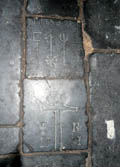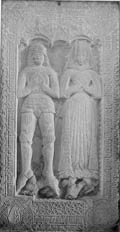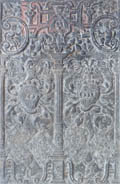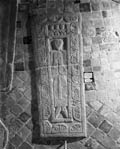Floor slabs as memoria
Grand tomb monuments have always attracted attention, but they are relatively few in number in the Netherlands,
compared to the more modest types of memorial. Yet there is a growing interest in engraved floor slabs and the
insights they can offer us, not just (socio-)historical, but also art-historical, genealogical and heraldic.
In the Middle Ages the dead were buried inside the church, or in the churchyard, or - when interred in a convent - in
other places such as the cloister. Graves often contained more than one body, as it was common for married couples,
or members of the same family, to be buried in a single grave. The practice of burial inside Dutch churches
officially ended in 1829.
Many medieval Dutch inscriptions begin with the text 'Here lies buried' (Hier leit begraven) and often end
with a request to pray for the souls of the deceased (Bid voor de ziel). However, some slabs mention only
the name of the deceased and the date of death. It was not unusual to commission a monument during one's lifetime: the
date of death could be added later, as one may still observe in some inscriptions. Graves
were often used by successive generations of the same family, which meant that more names and inscriptions were added
over time.
Graves could also be sold on or appropriated by the church for re-use, and slabs could likewise be re-employed. For
new burials one could simply add a new name, although earlier
inscriptions were sometimes effaced in order to replace them with new texts. Tomb slabs were (and still are) part of
the church floor, which means that many inscriptions and heraldic features have become illegible because of the wear
and tear from footsteps over the centuries. This can make it difficult or impossible to identify the persons
commemorated or to date a slab, unless there are additional sources of information.
Erosion of floor slabs is not a recent phenomenon, of course. Centuries ago the Utrecht antiquary Aernout van
Buchel (Buchelius, 1565-1641) already complained about worn tomb slabs in his
Monumenta,
which contains descriptions of tomb slabs and inscriptions that he found in churches and convents in Utrecht.
As there are no quarries providing suitable stone within the Dutch borders, stone had to be imported especially from
the Southern Netherlands (modern-day Belgium) and Germany. Blue limestone was often the material of choice, but
sandstone (e.g. Bentheim) and Íland limestone from Sweden were used as well, albeit
that these were very different in colour. Therefore, a good-quality, expensive stone slab such as
red marble
represented a statement of wealth and status, just as a larger and more elaborate slab
cost more in material, labour and transport.
Medieval floor slabs vary in appearance from simple stones with only a few lines of text or even just a
merchant's mark,
to larger slabs rich in inscriptions and heraldry. The most luxurious examples carried additional imagery, such
as the evangelist symbols or even effigies of the deceased. Moreover, some slabs were inlaid with
engraved
brass plates or other material, such as white marble
for faces, hands and other features.
In the parish church at Oudewater we find floor slabs commemorating priests as well as slabs for members of the same
families. Sizes vary from an impressive 232 x 170 cm for a large family grave to a more modest size for a regular
grave. Larger slabs obviously came at a price.
Relatively smaller slabs of, say, 50 x 75 cm were used to cover only part of the grave. In some medieval wills from
Norfolk (England) we find references to 'heart stones' that were meant to be placed in the centre. Dutch evidence
suggests that similar small slabs were often positioned at the head end. The earliest known, badly damaged register
of graves (c.1595) in the church archive at Oudewater provides a detailed pricelist for burial, including the cost
of slabs larger than a 'headstone' to cover a grave inside the church (een groter steen dan een hooftstuck binnen
de kerck op een graft). Even leading citizens could opt for small-sized slabs, as the examples at Oudewater
show.
Back to top
|





|
Disclaimer:
2011: web design by Charlotte Dikken (UU). This website was tested and works on Internet Explorer, Opera and Firefox
and is best viewed on a fully maximized screen. Some of the features on this site use JavaScript.

Last updated on: 7 May 2014.
|
|
|